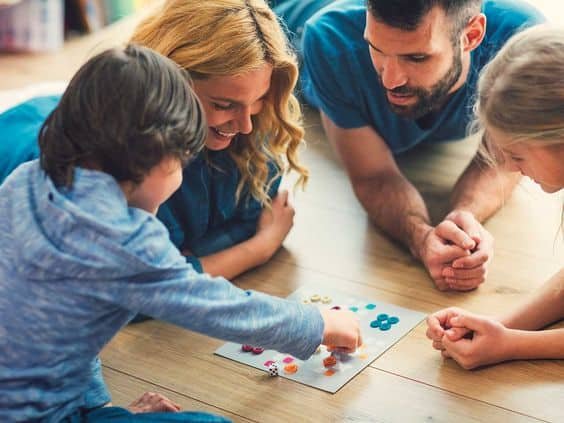
This is part of our series on board games by age. For more info check out our complete guide to picking the best game for your kids here.
Encouraging kids to play board games regularly will benefit them greatly. From birth through to about eight years of age, children’s brains develop very quickly and the neurobiological connections they make at this stage in their life will affect who they grow up to be. Playing board games as an alternative to being in front of a screen will teach them many positive traits and skills and will only benefit them in the long run, from both a social and academic perspective. This can be a great way to introduce a family game night without making it feel forced.
There are many different kinds of games out there and each one will offer them a different experience and teach them crucial skills. Some games will rely on cooperation and team work, which will help with their communication and collaborative abilities and teach them how to be supportive and empathetic to each other. Others will rely on them being able to problem solve and make critical decisions, as well as be able to explain their thought process in said decisions. If nothing else, joining in, in a sociable activity like board games will only help their inter-personal skills as they move up through school. These games are enjoyable for both kids and adults, making them perfect for family game nights.
Below are a selection of the nine best board games for five year olds. Each game is slightly different, both in terms of game play and what they offer. All are very accessible and easy to learn and make a great introduction for your kids to the world of board games. Not only that, but they are fun for all ages, which should make it even easier to instigate a regular board game night at home!
What are the Best Board Games for 5 Year Olds?
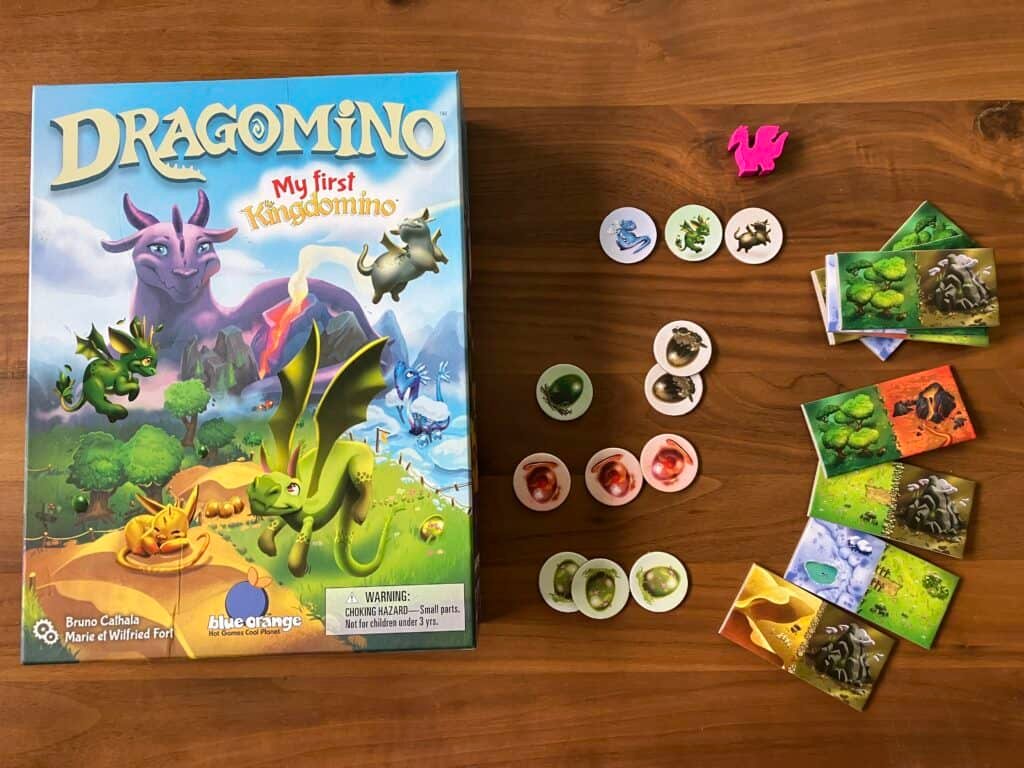
Dragomino
Ages 5+ Players: 2-4 Time: 15 minutes
Dragomino is a tile-laying board game based on Kingdomino, a game that older players may already be familiar with. The concepts behind both games are similar but the former distills its rules to make play a little more suitable and accessible for younger members of the family.
In Dragomino, each player takes up the mantle of ‘dragon trainer’ and the goal is to find as many baby dragons as you can. Gameplay is simple enough: on a player’s turn they draw a tile from the center of the board and then play a tile. Each half of a tile represents a different landscape, of which there are six in total, and players will want to try and lay matching landscapes next to each other. Doing so will allow the player to take an egg token corresponding to the landscape for each match they make. The player then flips the egg to reveal either a broken shell (worth 0 points) or a baby dragon (worth 1 point). Once all tiles have been taken gameplay ends and the player with the most points wins.
As you can see it’s as conceptually simple, as most domino-style games out there, but there are a couple of extra mechanics to consider. Eggs differ in probability depending on the landscape: some are much more likely to yield a baby and others to be empty. Once you crack (pardon the pun) the eggs most likely to have babies inside it helps you develop some form of strategy to plan your next move. Additionally, there is a mama dragon token in play which shifts place regularly. The last player in a round to open an empty egg receives this token, which means they go first on the next round. At the end of the game, whoever is left holding mama dragon gets one extra point to their final score too. That’s about all there is to it!
Dragomino is especially great for families with younger children as it streamlines the rules and keeps scoring simple and to the point. It introduces concepts like matching, problem-solving, probability assessment, and simple math skills. The game is engaging, challenging, and exciting and will act as a great gateway game for those looking to get their kids into the best kids games. Additionally, the game helps develop critical thinking skills through strategy and decision-making.
Read our full Dragomino Review here.
We earn a commission if you make a
purchase, at no additional cost to you.
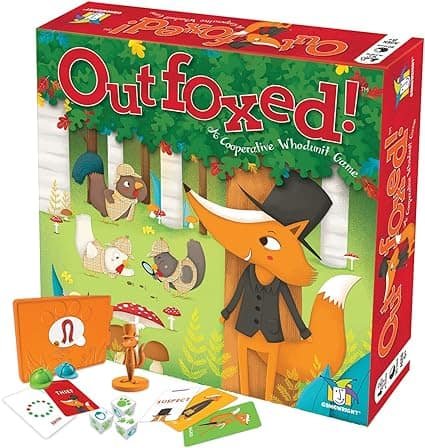
Outfoxed
Ages 5+ Players: 2-4 Time: 20 minutes
Outfoxed is one of the best cooperative games that introduces children as young as five to concepts like problem-solving, collaboration, critical thinking, and the skills of deduction. It’s a little Clue and a little Guess Who as you work together to catch the pie thief before he can get away.
In this cooperative whodunit game, players take on the role of chicken detectives to figure out which sly fox stole Mrs. Plumpert’s pot pie. Players move around the board gathering clues and use a special evidence scanner to try to gradually rule out the suspects and find the real thief.
On a player’s turn they announce whether they will search for clues or reveal suspects and roll three dice. Players get three attempts to match all three dice to the sign representing the action they wish to take. When searching for clues, players move around the board and aim to land on paw print spaces, which will then allow players to take a clue and place it in the special decoder. These clue cards represent items of clothing the culprit may or may not be wearing and the color shown in the decoder will give you hints as to whether you’re on the right track or not (green means they aren’t wearing this piece of clothing and red means they are). You can then remove any innocent suspects not wearing that piece of clothing from the game. If a player opts to reveal suspects, they can choose two and use the revealed items of clothing to try and guess if either of these is the pie thief. The player will need to try and remember whether the clothing was red or green and try to eliminate suspects not wearing the correct items.
Play continues like this until either the fox reaches the foxhole and escapes or the suspect is correctly named. A guess can be made at any time in the game but if the guess is wrong, the fox automatically gets away. If all suspects but one are left, if it matches the same card in the decoder the players win, but they lose if it’s not the correct one. The fox also has the opportunity to move throughout the game if a player does not roll the correct dice which will put pressure on the players to guess the correct culprit if their dice rolls are proving unlucky!
It’s a really simple game to grasp and great for players of a variety of ages. Older players can take the helm and encourage discussions surrounding the possible culprit in order to give younger players a chance to rationalize their decisions. It will also give them experience with working in teams and working together with others, which will come in useful for the future. Additionally, the game helps develop critical thinking skills through deduction and problem-solving.
We earn a commission if you make a
purchase, at no additional cost to you.
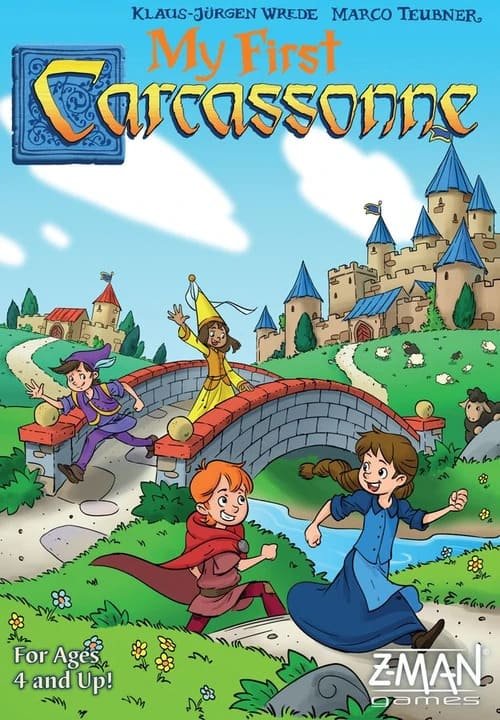
My First Carcassonne
Ages 4+ Players: 2-4 Time: 30 minutes
Not that the original Carcassonne had the most complicated rules, but My First Carcassonne takes the original formula of traditional board games and gives younger children a simpler version of the classic game that creates an enjoyable experience for all ages of the family.
The premise is simple: during a national holiday, chickens, sheep, and cows are let loose on the streets of Carcassonne. It’s up to the children of the city to round the animals up before dusk. Players take turns laying tiles in order to build the game’s namesake and make the city larger and larger. Each card has an illustration of a child on it and as play unfolds you’ll see dozens of depictions of these children trying to round up various animals from the streets. When a street is closed off with at least one child with a corresponding player’s color, that player can place a meeple (token) onto the board. Whoever places all of their tokens first is the winner! That’s about all there is to it.
Whilst not as complex as Carcassonne (which, again, was not that complicated to begin with) luck aside, this version still does require a small degree of strategy for those players aiming to score high when drawing their tiles. Scoring never goes very high and the game only possesses a fraction of the tiles its bigger brother does. This serves to not only make it easier for younger players to keep track of their score, but to keep the length of each game to a reasonable duration also. This combined with minimal rules makes it a great game to introduce to young kids and serves as a gateway to the original Carcassonne!
Additionally, My First Carcassonne serves as an educational game that teaches strategy and planning, fostering cognitive and social skills in young children.
Check out our full My First Carcassonne review here.
We earn a commission if you make a
purchase, at no additional cost to you.
Concept Kids: Animals
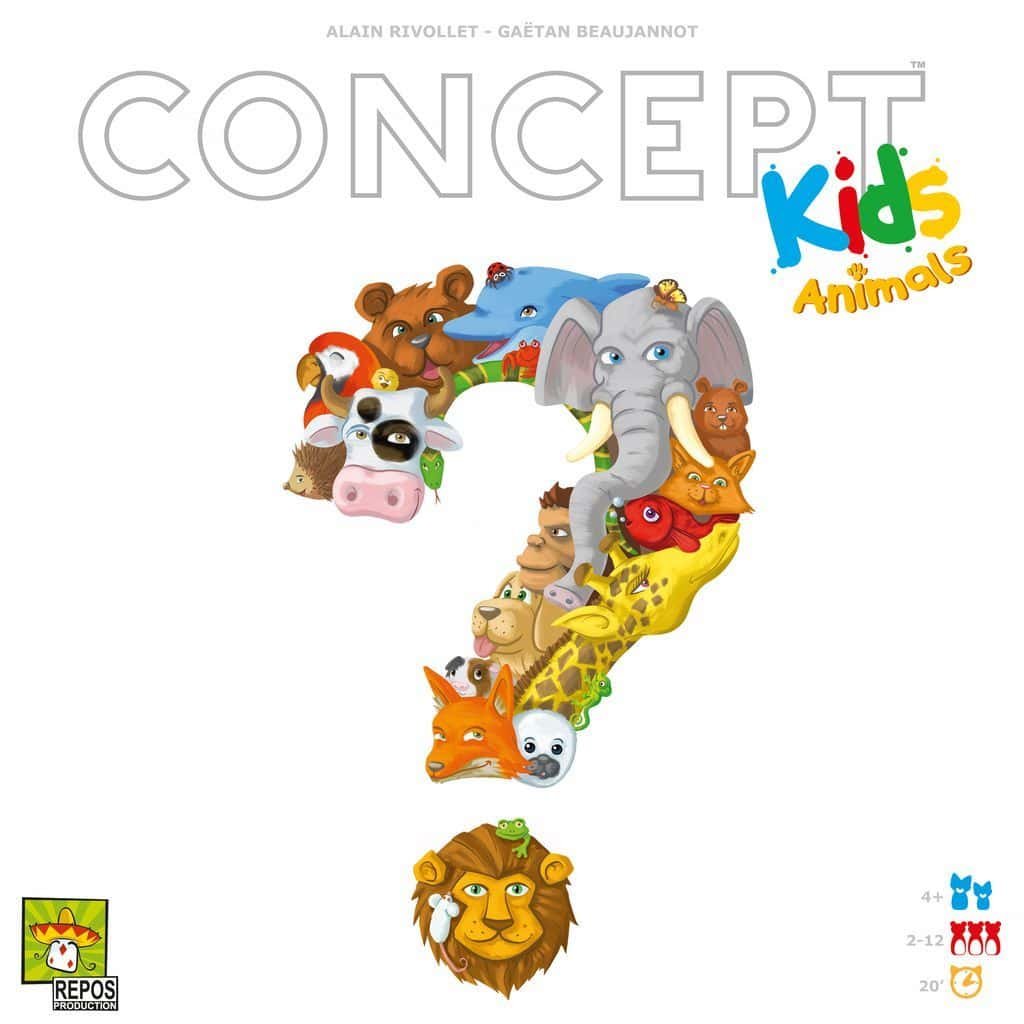
Ages 4+ Players: 2-12 Time: 20 minutes
A great, cooperative, guessing game for as little as 2 and as many as 12 players that’s so simple to learn that almost anyone can play. It’s one of those family games that’s great when played with families together and relies on non-verbal communication to help players guess which animal they’ve selected out of over 100 (though luckily not all are present in one game)!
At the start of the game, twelve cards are selected and serve as the animals that need to be guessed. Each turn one of these cards is displayed outwards on a special holder for the other players to see and it’s their job to help the guessing player guess which animal is in front of them. This is done through the game board, which has a variety of different symbols representing aspects like color, shape, habitat, whether they’re nocturnal or diurnal, and herbivorous or carnivorous. Players can help each other choose what they think is the best symbol and when ready, the player in control of the cards guesses. They can have as many guesses as they like but if they give up and can’t figure out the animal they don’t receive a point. If they do get it right, regardless of the number of guesses, they receive a point and play continues until all twelve cards have been played.
Scoring is ranked via a chart to show how well everyone did, which acts as a nice incentive to encourage players to try and improve upon their previous score and climb the mountain higher towards the prestigious ‘Legendary Lion’ score. The game encourages the player in charge of the card to be an adult, which means it’s designed for parents to play with their kids but there’s nothing to say an older sibling can’t be in charge also. There are also alternative rules to scale the difficulty, so whilst the ideal age for this game would be five, there are plenty of opportunities to have children of all ages join in.
Another super simple concept to grasp that helps children exercise the ideas of teamwork and deduction. As one of the best educational games, it teaches children about animal characteristics while being fun and engaging. With it being so easy to grasp that you can learn it almost immediately, It’s a perfect game for younger kids but fun for all ages!
We earn a commission if you make a
purchase, at no additional cost to you.
Magic Maze Kids
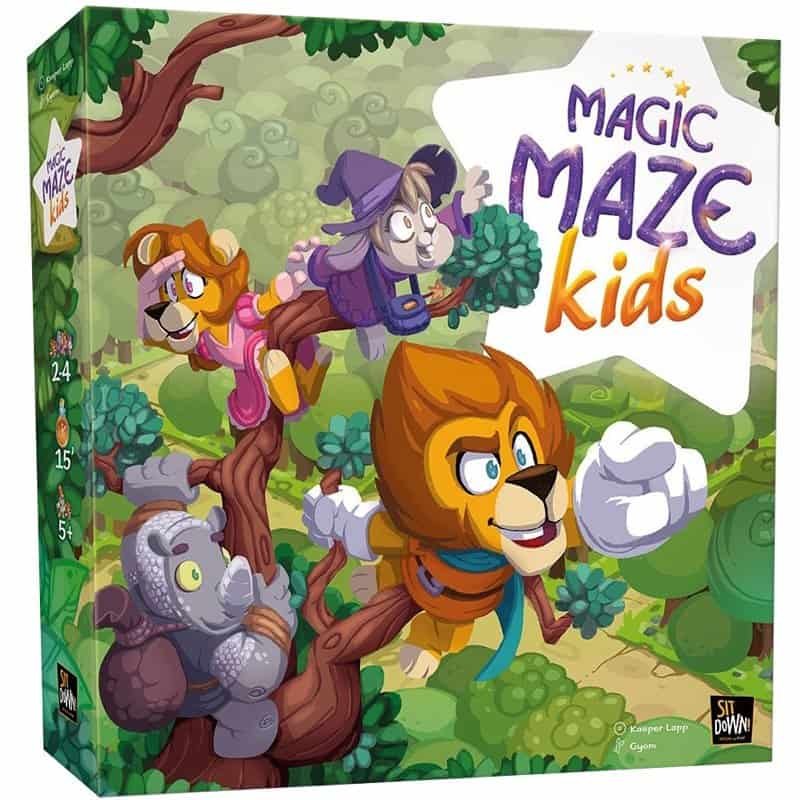
Ages 5+ Players: 2-4 Time: 25 minutes
Magic Maze Kids is one of the best cooperative games for young children. Don’t you hate it when your king gets turned into a frog and YOU have to be the one to go find the ingredients to make a potion to change him back? Well that’s exactly what Magic Maze Kids is all about – so as long as you don’t mind lending the kingdom a paw, you and up to three friends work cooperatively to navigate mazes to bring the king back to his old self.
Not only is this a cooperative game where everyone wins or loses together, but all players can control all characters at any given time. Players are given action cards that serve as directions and as long as they possess the right card and feel it’s appropriate to move the character then they can do so. They can only move the character in this one direction and will have to collaborate with others to ensure the goal is reached before time runs out. This adds an element of complexity to the game but nothing too overwhelming, just a different take on everyone having their own individual piece. Each character in the game (the prince, princess, knight, and magician) all have different abilities and when navigating the threats of the board, players will need to utilize these correctly in order to win. Each game board has a slightly different setup but the task remains the same, players pick a certain amount of mission cards and must work together to complete them. The boards become more challenging with new obstacles, monsters, and rules added each time. When all ingredients have been collected the potion restores the king to his old self and the players win!
Magic Maze Kids is a little more cerebral than some of the other games listed but is still a straightforward game once you’ve had some practice with it. There is a degree of flexibility to the game where it offers optional challenges and makes recommendations that will vary the game experience. The instructions will also gradually introduce more mechanics as you progress through the game boards so regardless of age and ability, there is something here for everyone. As an educational game, it teaches teamwork and problem-solving skills. While Magic Maze Kids is cooperative, there are also many great competitive games for kids.
Check out our full review of Magic Maze Kids here.
We earn a commission if you make a
purchase, at no additional cost to you.
Quacks & Co.: Quedlinburg Dash
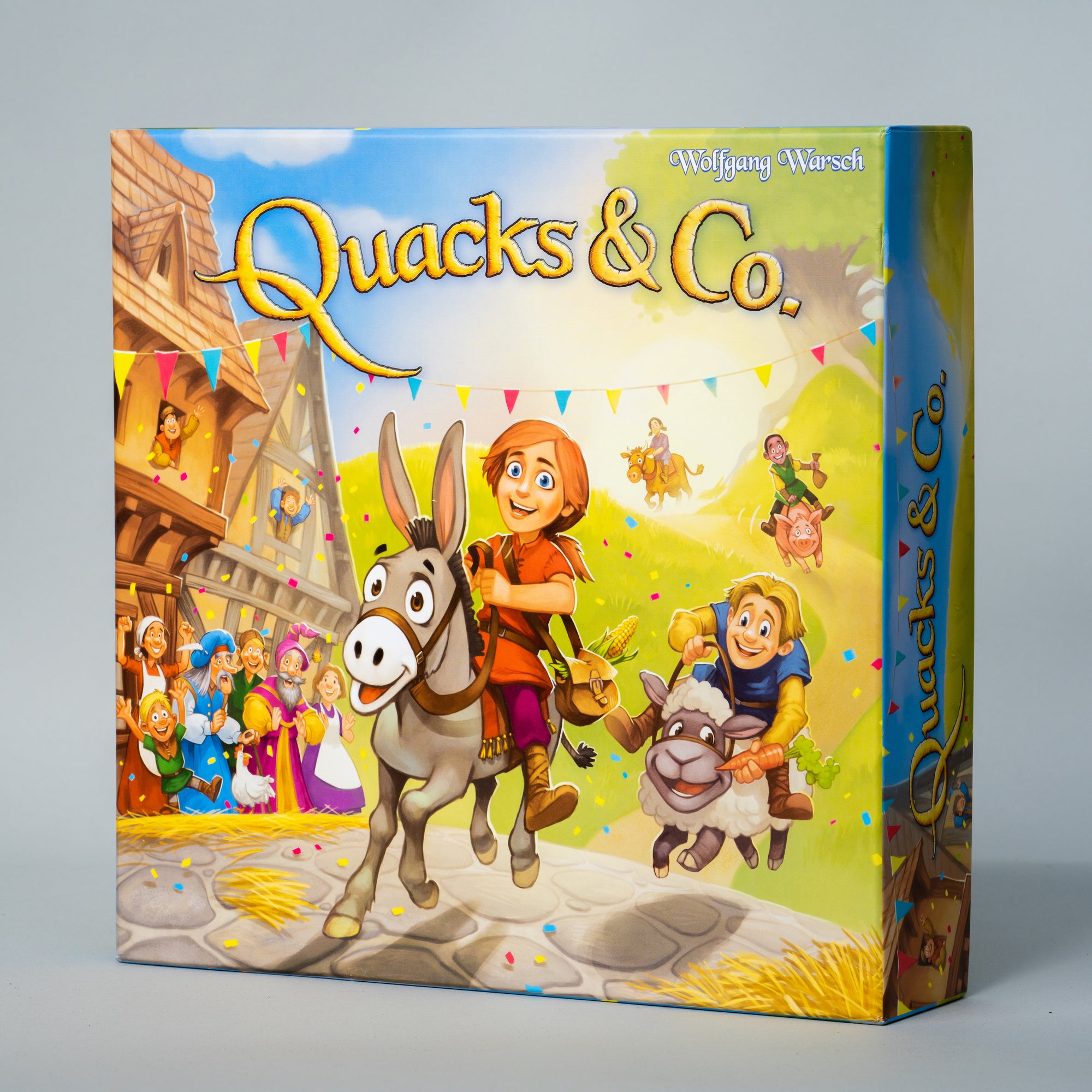
Ages 8+ Players: 2-4 Time: 45 minutes
Quacks & Co.: Quedlinburg Dash is a bag building game based on its big brother The Quacks of Quedlinburg. Players choose an animal – donkey, pig, cow, or sheep – and will take turns drawing tokens out of their bag representing different foods they’ll be feeding their animal on their journey to the big city. Along the way players will earn rubies, which can be spent to purchase new foods to put into their bag that will allow their animal to move faster and give them additional benefits.
The theme is whimsical and the act of pulling tokens out of a bag is immensely satisfying to kids. It is also clever to have them purchase additional stuff to build their bag over the course of the game. The way they’ve set it up is, you have four dream weeds in your bag to start the game, and every time you draw your third one, you “bust”. But instead of having that be a wasted turn, you go to the market when you bust and you can spend your rubies on something new to add. In a game where you are constantly busting, they managed to make every turn still feel positive.
My favorite part of this game is that there are multiple levels of difficulty in the box. Young kids will start with the simplest set of chips, but then you can change the effect of those chips to be a bit more complicated, or add in additional chips with advanced effects. Because of all the options, you can dial in the perfect complexity level for your kid.
As a result it’s a game that your kids can grow with over time starting with the simplest set, but learning new and more complex mechanisms as they get older and more sophisticated.
This is great one to get a conversation started about cheating and why it’s not as fun when you do. Looking in the bag is tempting when you want to pull out the perfect chip and race ahead on the board, so it’s a good learning opportunity and a low stakes way to have that conversation.
Pick this one up. You and kids will be able to enjoy it together for years. And when they are ready, pick up Quacks of Quedlinburg to continue your bag building journey.
We earn a commission if you make a purchase,
at no additional cost to you.
My First Castle Panic

Ages 4+ Players: 1-4 Time: 20 minutes
My First Castle Panic, the kids version of the classic Castle Panic, is a fun and colorful cooperative game for little ones. For 4 and up, 1-4 players, 20 minute playtime, this game is perfect for short attention spans.
In My First Castle Panic players work together to keep the monsters from the path from reaching the castle. Each player draws cards that match the shapes and colors on the path and work together to catch and eliminate the monsters before they get to the castle walls. It’s cooperative so everyone wins or loses together.
It’s got big, colorful pieces for little hands, simple rules to help introduce kids to new concepts, engaging artwork and a fun theme to keep kids engaged, and cooperative gameplay to help them learn communication, sharing, and working together.
As kids work together to defend the castle they learn the basics of strategy and decision making in a safe environment. This educational game teaches teamwork and problem solving. It’s a great choice for first board game, and since it is cooperative, it’s the perfect choice for family bonding.
Check out our Full My First Castle Panic Review here.
We earn a commission if you make a purchase,
at no additional cost to you.
Rhino Hero
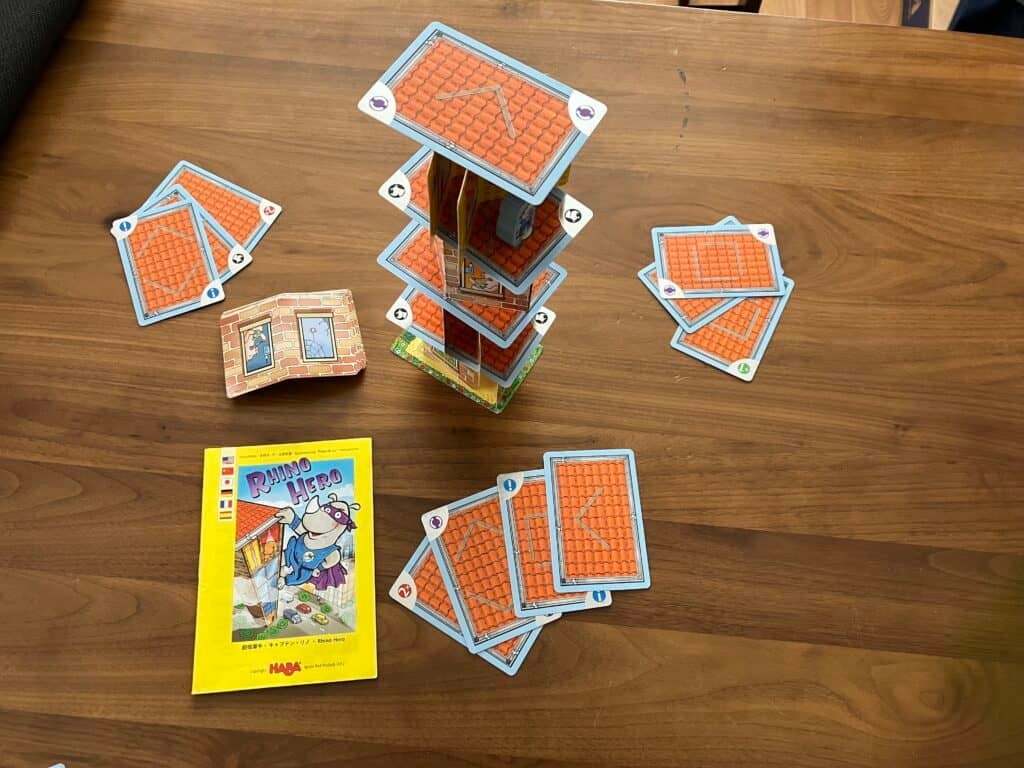
Ages 5+ Players: 2-5 Time: 10-20 minutes
Rhino Hero is one of the classic dexterity games that gets kids imagining themselves as super heroes saving people from tall buildings, as they take turns adding stories onto an eventual skyscraper. It’s great for five year olds, which is why it makes this list, but it you’ll find it works well at many age ranges. Older kids will enjoy it as well and it’s a great one for kids to play together, once they’ve got the hang of the rules.
At the beginning of the game players get a hand of cards that they can play as the roof of the next story. They’ll need to successfully place the walls in the pattern indicated on the previous roof card, before placing their card on top, testing their fine motor skills. Sometimes, roof cards will require places the Rhino Hero as well, making it extra challenging to avoid toppling the tower.
Some cards have different effects and might allow a player to play two cards at once, but ultimately, the player that is able to get rid of all their cards first wins. Unless someone knocks over the tower, in which case that person loses.
I will say that the card play can be a little cumbersome for some kids while they are getting the hang of things, so sometimes I’ll just ignore the special effect cards and just have kids take turns adding to the tower until someone knocks it down. That allows kids that haven’t played a lot of games to immediately enjoy it.
All in all Rhino Hero is a quick accessible game that reliably gets people to the table and creates a lot of silly fun. The theme and the artwork are charming and perfectly aimed at the audience. This is one that is great fun to play with your kids and because it is a dexterity game, will still provide some challenge, even after repeated play. A family classic and one everyone should consider for their five year old.
Check out our list of the best dexterity games for kids here.
We earn a commission if you make a purchase,
at no additional cost to you.
My First Stone Age
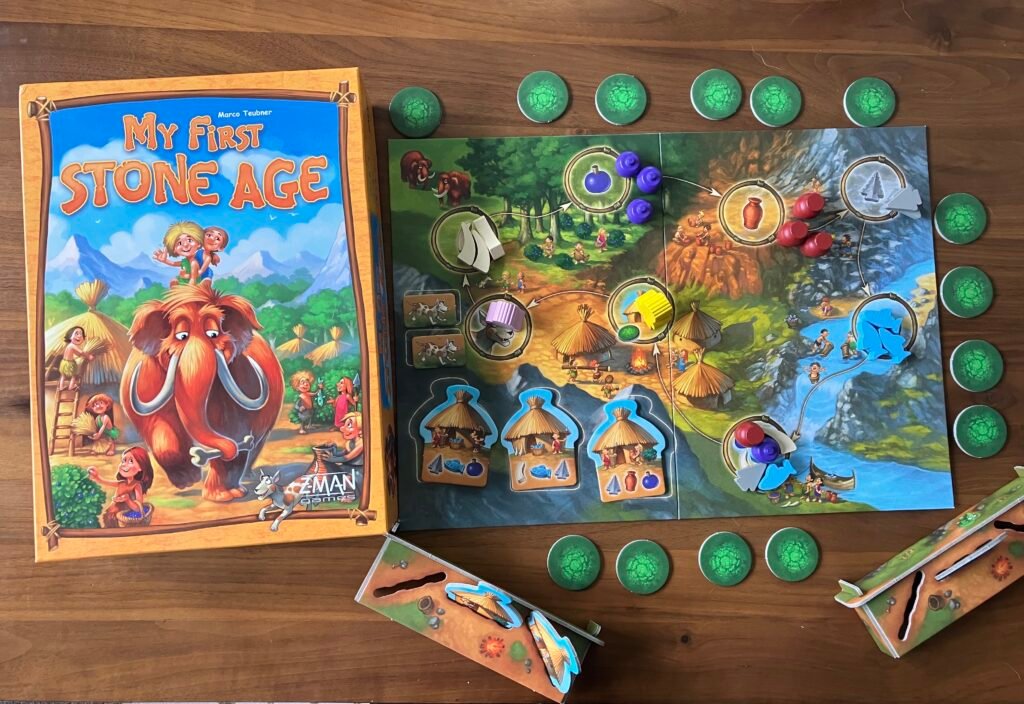
Ages 5+ Players: 2-4 Time: 15-20 minutes
My First Stone Age, the kids version of Stone Age, is a great option to introduce young children to the basics of resource management and contract fulfillment. Suitable for ages 5 and up, the game supports 2 to 4 players, with each session typically lasting between 15 to 20 minutes, making it ideal for young audiences with shorter attention spans.
In My First Stone Age, players take on the roles of prehistoric families who are striving to build their settlements. The game begins with each player collecting resources such as berries, fish, and pottery but, rather than being a basic roll and move game, players have to rely on their memory skills to select the facedown tile that will take them where they need to go on the board. It’s a big step up from the simple memory games they’ve played before, but it builds on those core skills.
I found that this game did an incredible job of introducing complex concepts like worker placement and contract fulfillment than any other kids game I’ve played, so if you are hoping that your kids will grow into your game group, look no further.
That said, kids will get a kick out of the theme and the components are top notch, big chunky wooden pieces, and an interactive system for tracking their progress as they build huts. Great for this age group and one you’ll enjoy playing with your kids.
We earn a commission if you make a purchase,
at no additional cost to you.
Conclusion
Family games that include the little ones are fun and help develop important skills like teamwork, strategy and problem solving. Games like Concept Kids: Animals and Magic Maze Kids are designed to be inclusive and fun for all ages so everyone in the family can play. These are our top picks for little ones because of their complexity, skill development and independence.
By choosing games with simple rules but varying levels of difficulty, parents can keep their kids challenged and entertained as they grow. These games are great for family bonding and creating lasting memories. Playing board games strengthens family relationships and reduces stress. So whether you’re introducing your kids to board games or looking for new additions to your collection, these are great options to consider. Happy gaming!
